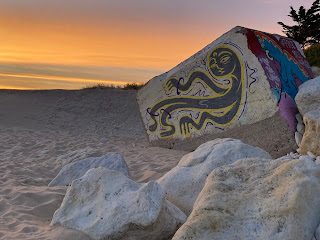Ile de Ré is essentially the French Martha's Vineyard. There are a handful of charming villages with classic central places (a café, a bakery, a few small shops). Much of the land remains agricultural, mostly given over to grapes. The coast is at once both beautiful and fierce -- the long sandy beaches are punctuated by limestone cliffs and various rocky layers of seabed that emerge at low tide, and the winds and currents can generate formidable square wave patterns.
A smallish year-round population of retirees, local business owners, and laborers includes many families with deep island roots, still selling oysters and harvesting sea salt. There are $5 million second homes down the street from family campgrounds with ball courts; there are luxury boutiques with grotesquely expensive purses close to deteriorating Nazi lookout bunkers. During summer everywhere is at max capacity, with roughly 200,000 tourists that cannot get enough of the artisanal ice cream and/or riding bikes incredibly slowly down the middle of the road.
It is a low-lying, windswept, and (despite the tourists) rather quiet place. In addition to the abundant shellfish, an early attraction was the natural predisposition for salt harvesting. There are great swaths of tidal marsh where shallow pools gradually evaporate at low tide. While today it's merely tasty and full of minerals, salt in the Middle Ages was scarce and in high demand, and with a bit of engineering, humans maximized the yield. Thus did La Rochelle become France's biggest port, and its citizens leveraged significant political and religious autonomy. Salt from the island is still a coveted commodity, sold across France for about 20 times the usual price.
There is a scenic bike path that winds through the salt marshes near Loix, in the farthest corner of the island. The cool autumn evenings and waning daylight have tinged the leaves. We cycled past yellowing vineyards, entered the muted gray silt and sere-blond grasses of the marsh, dotted with white seagulls and the occasional balletic egret. Rich, red-purple glasswort(?) bearded the pond-grid. And "flowers" of salt imperceptibly crystallized, molecule by molecule, drawn from the sea by the sun and wind.





No comments:
Post a Comment